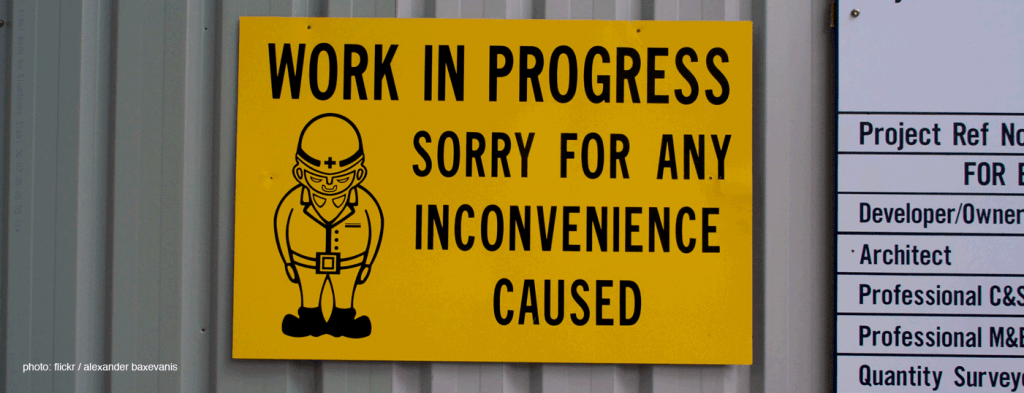Do you ever have a day where you are just running on all cylinders, you move from one task to another, accomplishing more in a day than some people do in a week? Do you ever have a day where you’ve run out of gas, it seems you get nothing done, and despite your desire for it to have been a productive day, you have nothing to account for during the time you were awake?
What’s the difference between those two days? How do you have more of the former and less of the latter?
Motivators and Demotivators
The difference often lies in small, seemingly inconsequential events or activities, triggers that either motivate or demotivate you to work on what you should be working on.
For example, if I receive praise at the office for a project I’m working on, something as simple as “Drew, great work so far on the X project”, I’m more motivated to work harder on that project–I want to keep up the good work and continue it through to completion. On the flip side, if I talk at the water cooler with someone who has a negative attitude towards their work or a project we’re on, I sometimes find it incredibly difficult to get back into what I need to get done.
That’s because these events and activities have a mental and emotional effect on me. The praise lifts my spirits and re-enforces that what I’ve been doing is appreciated. Hearing cynicism doesn’t necessarily make me dislike the project, it just doesn’t put me in a mood to work. Both of these events might take approximately the same amount of time (depending on how long the person talks), but they leave me in completely different mental states. By pinpointing these events and understanding their effects, we can start to find ways to control our entire day.
The Right Motivators for the Right Projects
Everyone has multiple things on their plate, multiple roles they must play on a daily and weekly basis. I am a project manager/entrepreneur/stand-up comedian/improviser/blogger/writer, and those are just my “job” roles. You can also throw in son, brother, friend, apartment owner and many more. Given all of these responsibilities, it’s important to be able to stay focused on the task at hand–I can’t be revved up to clean my apartment while I’m at work, and I shouldn’t be ready to create a project plan right before I’m about to go on stage.
That’s why it’s important to understand that not all motivators are equal, and not all are appropriate for your different roles. In fact what motivates you in one area will often demotivate you in another. If I work on stand-up ideas on the subway on my way to work, when I get to the office, I want to continue writing jokes instead of prepping for a board meeting.
Instead, I should be using my time on the subway doing something that will motivate me in the office, so I can hit the ground running. I’ve found that reading business books, looking at my upcoming work tasks, and just mentally reviewing the current status of some of my work projects allows me to be ready to work once I get settled in my cube.
Identifying Your Motivators and Demotivators
Getting back to the original question, the difference between your productive and non-productive days is often the difference between whether you had the right motivators helping you throughout the day.
In order to start increasing your number of productive days, you have to purposefully do things that will motivate you for the appropriate task at hand, and consciously avoid the things that will demotivate you. Luckily, finding these triggers is as easy as observing your behaviors.
Think back to the last time you had a great day. How did it start? What was the first thing you did in the morning? Throughout the day, how did you recharge? What did you do before each of your big tasks? What was missing, what didn’t you do? Now, think back to a day where you felt sluggish and got very little done. How did it start? What was the first thing you did in the morning? What other things did you do and not do throughout the day?
Ask yourself these same questions for each of your roles. Think of the last time you had a really productive day at the office, or in taking care of the kids. Based on these answers, you can start to identify your triggers. Write them down and think about what role they motivate you for.
To help you get started, here’s a list of some of my motivators and demotivators, with their role in parenthesis. Keep in mind that a trigger can be as big as waking up early or as small as listening to a certain song.
Motivators
- An energizing work out (Multiple).
- Waking up early (Multiple).
- Listening to upbeat music (Multiple).
- Reading a business book (Work).
- Reviewing promotion criteria (Work).
- Looking at Google Analytics (Blog).
- Watching stand-up promo video (Stand-up).
Demotivators
- Hitting snooze (Multiple).
- Aimlessly browsing websites (Multiple).
- Watching TV (Multiple).
- Taking too long of a lunch (Work).
- Checking personal email (Work).
- Writer’s block (Blog).
- Performing for a small audience (Stand-up).
Building Consistency
With this list in your arsenal, you can now increase the liklihood of having a great day. Whenever you’re stalling on a project, return to your list and find one of your triggers for your current role. Over time, as you use the same triggers, they’ll become even more powerful conditioners, essentially becoming a Pavlovian bell that mentally hypes you up. To build a wildly productive day, you can string these motivators throughout, all-the-while avoiding demotivating triggers.
As more people embrace the “slash effect,” as coined in One Person, Multiple Careers, rarely will you go through an entire day where you only have to work on one of your roles. It’s more likely that you’ll move in between your various roles throughout the day, sometimes coming and going between four or five of them. Your motivators can serve as very important transition tasks when you go from one role to another, maintaining your momentum from the previous project. This is especially true if that transitioning task is simple.
Let’s say that one of your motivators for cleaning up at home is listening to “Splish Splash” by Bobby Darin (I don’t know, it could happen). After a long day of productive work, you may not be in the mood to clean up. So rather than throw out any intention of cleaning up, or trying to force yourself to work through that pile of dishes, you just start splishin’ and a-splashin. After a few minutes with Mr. Darin, you’ll be more inclined to tackle what awaits you in the sink.
Motivators in Action
To bring the concept home, let’s take a look at how a productive day for me might go:
I know that if I hit snooze in the morning, I’ll have a slacker mentality in the back of my head for the rest of the day. But, if I wake up early and exercise, I’m more likely to want to continue to be productive in my other roles. So I wake up early, workout, and then on the subway to work, read a business book to mentally prepare for the corporate world.
After a few hours of work, I take a break to re-charge. I walk around and talk to people or go back to the business book. Once I have some more energy, I jump back into the appropriate mindset for my projects.
This continues throughout the day until it’s time for me to leave for my next role as a stand-up comedian. On my way to the comedy club, I now have to go from Corporate Drew to Comedian Drew, so I listen to a few songs to hype me up, review my set-list, and smile more. I have a great set, see the other comedians, and then head home.
If I was done for the night, then I’d do whatever I wanted to rewind. Since there’s always something to be done, and I still have some energy, I spend my walk home brainstorming ideas for some sketches I have to write later in the week. When I get home, I’m now in the right mindset to start writing some of them out. I finish up with the sketches and, since it’s nearing my bedtime, I spend some time on important tasks that are sometimes demotivating, such as checking my personal email or catching up on some TV shows.
You can see that throughout the course of a single day, you might use ten or twenty triggers to motivate you for the task at hand. Equally important, you might consciously avoid ten or twenty triggers that demotivate you. In the end, you’ll have a number of items checked off on your to-do list, and you’ll have the answer the question–what’s the difference between the productive and unproductive days.




Absolutely right. Positive motivation is incredibly powerful. So is not hitting the snooze button 14 times (see other post!).
Pingback: The Carnival of Inspiration and Motivation - Kay Holdsworth.com